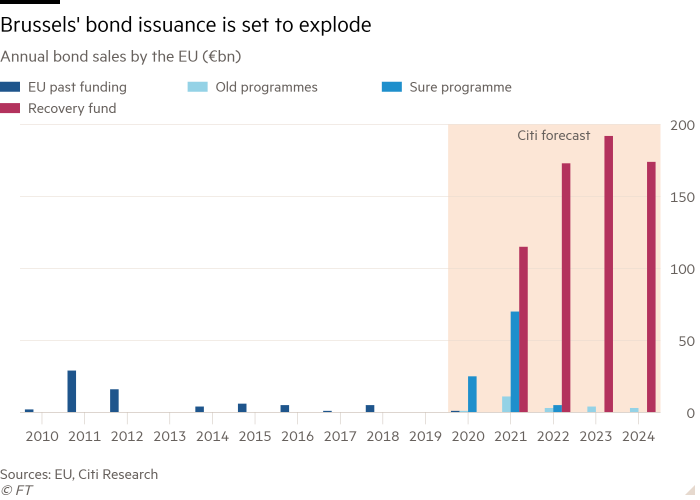The EU itself is set to become one of Europe’s largest bond issuers as it turns to financial markets to fund the €750bn coronavirus recovery package agreed on Tuesday morning.
Investors say the coming explosion in debt issuance by Brussels could help create a new pricing benchmark across the region, while bolstering the euro’s role as a reserve currency.
“I think this will transform capital markets in Europe,” said Philip Brown, head of public sector debt capital markets at Citi. “You’ll have a shared safe asset that’s large enough to find its way into government bond indices and government bond portfolios.”
The EU already has a small presence in bond markets, with some €50bn of bonds outstanding, most of which was used to fund loans to Ireland and Portugal during the region’s debt crisis nearly a decade ago. But that sum will be dwarfed by €196bn of debt sales next year alone, with similar amounts to follow in 2022 and 2023, according to projections by Citi strategist Michael Spies.
By the end of next year, the EU’s borrowings (including other Europe-wide institutions like the region’s bailout funds and the European Investment Bank) will total €980bn — roughly the size of Spain’s bond market. Only the heavyweight trio of Italy, France and Germany will eclipse Brussels’ own debt pile, according to Mr Spies.

Paul O’Connor, head of the UK multi-asset team at Janus Henderson Investors, said the recovery fund deal represented the first time EU leaders had agreed to joint debt issuance on a meaningful scale, according to
“The symbolism here is very important,” he said, describing the move as the eurozone’s “first real attempt at mutualising debt and its biggest step yet towards fiscal integration”.
Bond investors have few options if they want to buy top quality European debt in large sizes. Berlin’s frugality over the past decade has led to a dwindling supply of German Bunds, while Italy and France, the bloc’s two largest debtors, do not have premier credit ratings. But the EU is rated triple A by two of the three big agencies.
“There’s a huge amount of demand out there for these kind of assets,” said Iain Stealey, chief investment officer for international fixed income at JPMorgan Asset Management. “And they’ll be attractively priced relative to cash or German bonds. You get a yield of close to zero — and it’s a sign of the world we live in that that’s exciting.”
An EU bond maturing in 2031 trades at a yield of minus 0.14 per cent, roughly in line with similar French debt but well above the German equivalent, which yields minus 0.47 per cent.
Riskier debt across the eurozone rallied as EU leaders neared a deal on Monday, pushing Italy’s 10-year yield to 1.07 per cent, the lowest since early March. Fund managers like Mr Stealey say a deeper pool of EU issuance should make Italian debt more attractive, because Rome will be able to fund at least part of its response to the crisis at cheaper rates.
The European Central Bank, for its part, has announced plans to buy almost an extra €1.5tn of bonds in response to the economic and financial fallout from the pandemic, on top of the €2.6tn it already owns.
But the ECB has been criticised for weighting its bond purchases towards the hardest hit countries — such as Italy — and could now shift some of its purchases towards the new EU bonds. The central bank can buy up to 50 per cent of debt issued by supranational institutions.
The new supply of EU bonds is also likely to catch the eye of foreign reserves managers, potentially bolstering the appeal of the euro, according to ING strategist Antoine Bouvet. “This borrowing may be temporary in nature, but it’s big enough and liquid enough . . . to think about buying,” he said.
Some investors remain unconvinced that the recovery fund is a stepping stone to greater fiscal integration within the eurozone. The €750bn of grants and loans for member states comes with conditions attached — including a requirement to undertake economic reforms.
“Everything about this is limited and conditional,” said James Athey, a fund manager at Aberdeen Standard Investments. “Italy can’t just take this money and pay its civil servants. If . . . this crisis can’t get us to more meaningful fiscal transfers between members, it’s hard to see what can.”
Moreover, in one crucial respect, the EU issuance stops short of a full mutualisation of debt. The bonds come without so-called cross default clauses, which means that individual member states are not on the hook for repayment if Brussels were to default.
That makes the EU’s triple A status vulnerable to any future political crisis, according to Moritz Kraemer, former head of sovereign ratings at Standard & Poor’s.
The recovery loans are not due to be repaid in full for nearly four decades, leaving plenty of time for questions about the EU’s future to re-emerge. “A traumatic EU break-up looks unlikely today,” Mr Kraemer said. “But a lot can go wrong before 2058.”
https://news.google.com/__i/rss/rd/articles/CBMiP2h0dHBzOi8vd3d3LmZ0LmNvbS9jb250ZW50L2RhMGY3MWU0LWU2MjktNDA0ZC1iYTY1LWZlMWRjZjNkNGExNNIBP2h0dHBzOi8vYW1wLmZ0LmNvbS9jb250ZW50L2RhMGY3MWU0LWU2MjktNDA0ZC1iYTY1LWZlMWRjZjNkNGExNA?oc=5
2020-07-22 03:00:47Z
52780942311864
Tidak ada komentar:
Posting Komentar